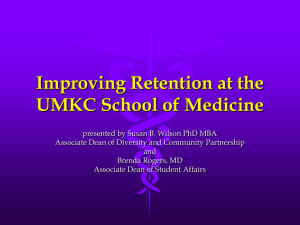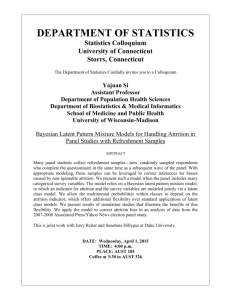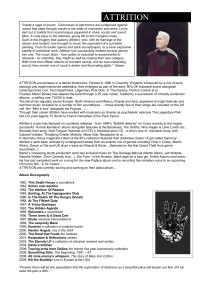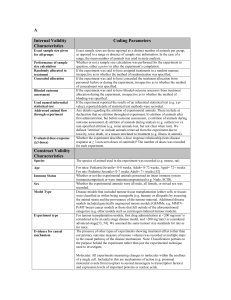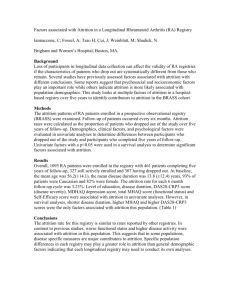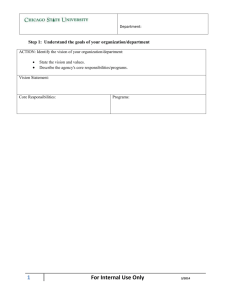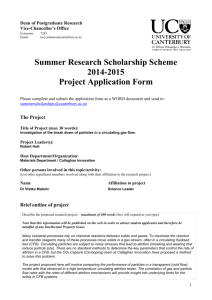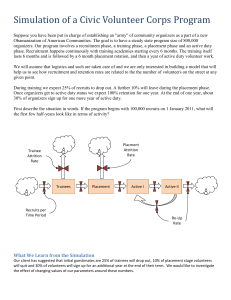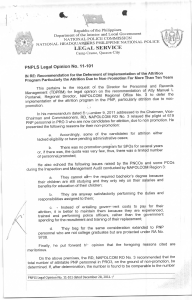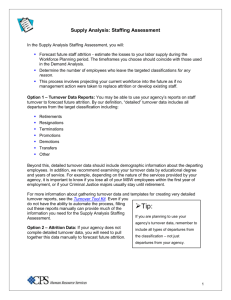Enrollment Management Plan Goal 1 – Maintain a fall enrollment of
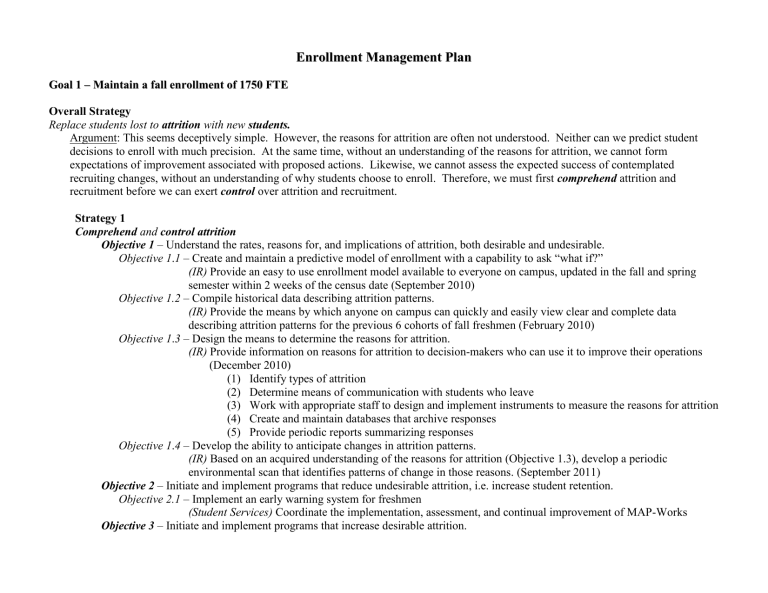
E n r o l l l l m e n t t M a n a g e m e n t t P l l a n
G o a l l 1 – M a i i n t t a i i n a f f a l l l l e n r o l l m e n t o f f 1 7 5 0 F T E
Overall Strategy
Replace students lost to attrition with new students.
Argument: This seems deceptively simple. However, the reasons for attrition are often not understood. Neither can we predict student decisions to enroll with much precision. At the same time, without an understanding of the reasons for attrition, we cannot form expectations of improvement associated with proposed actions. Likewise, we cannot assess the expected success of contemplated recruiting changes, without an understanding of why students choose to enroll. Therefore, we must first comprehend attrition and recruitment before we can exert control over attrition and recruitment.
Strategy 1
Comprehend and control attrition
Objective 1
– Understand the rates, reasons for, and implications of attrition, both desirable and undesirable.
Objective 1 .
1
– Create and maintain a predictive model of enrollment with a capability to ask “what if?”
(IR) Provide an easy to use enrollment model available to everyone on campus, updated in the fall and spring semester within 2 weeks of the census date (September 2010)
Objective 1.2
– Compile historical data describing attrition patterns.
(IR) Provide the means by which anyone on campus can quickly and easily view clear and complete data describing attrition patterns for the previous 6 cohorts of fall freshmen (February 2010)
Objective 1 .
3 – Design the means to determine the reasons for attrition.
(IR) Provide information on reasons for attrition to decision-makers who can use it to improve their operations
(December 2010)
(1) Identify types of attrition
(2) Determine means of communication with students who leave
(3) Work with appropriate staff to design and implement instruments to measure the reasons for attrition
(4) Create and maintain databases that archive responses
(5) Provide periodic reports summarizing responses
Objective 1 .
4 – Develop the ability to anticipate changes in attrition patterns.
(IR) Based on an acquired understanding of the reasons for attrition (Objective 1.3), develop a periodic environmental scan that identifies patterns of change in those reasons. (September 2011)
Objective 2 – Initiate and implement programs that reduce undesirable attrition, i.e. increase student retention.
Objective 2.1 – Implement an early warning system for freshmen
(Student Services) Coordinate the implementation, assessment, and continual improvement of MAP-Works
Objective 3
– Initiate and implement programs that increase desirable attrition.
Objective 3.1
– Increase rates of academic progress
(Advising) (AIM ) program initiative?
Objective 3.2
– Increase the 4, 5, and 6-year graduation rates
(Advising)
(Academic Affairs)
Strategy 2
Comprehend and control student recruiting
Objective 1 – Understand the admission decision process exercised by prospective students and their parents
Objective 2 – Improve communication with prospective students
Objective 3 – Increase the efficiency with which admissions counselors recruit new students
Objective 4 – Improve the overall marketing strategies used to recruit students
Objective 5 – Incorporate assessment into currently un-assessed activities
Objective 6 – Increase the scope of collaborative efforts with other staff offices and faculty
(Under development, but don’t be shy about proposing a contribution)
G o a l l 2 – I I n c r e a s s e r e c r u i t e d s s t t u d e n t t q u a l l i i t t y
Overall Strategy
Identify characteristics of student quality and then attract more students with those characteristics.
Argument: We define student quality as potential for success. In other words, a higher quality student will be one that is more likely to succeed. In order to determine the characteristics associated with the potential to succeed, we find those characteristics successful students share in common. More higher quality students will result in a higher rate of success. Having acquired a greater understanding and capability for recruiting students (Goal 1), those abilities will be directed in particular to attracting higher quality students.
Strategy 1
Identify characteristics of student quality
Objective 1
– Through predictive modeling, identify characteristics associated with success.
Objective 2
– If possible, understand the causal relationships involved.
Objective 3 – Improve the measurements of success and predictive variables.
Strategy 2
Attract more high quality students
Objective 1
– Increase the percent of the freshman class in the top 3 deciles of their HS class
Objective 1.1 – Increase the effectiveness of available scholarship funds in the recruitment of prospects in the top 3 deciles
( Admissions, Financial Aid) Assess past strategies to determine what changes could be implemented to increase effectiveness of these funds
Objective 2
– Increase the freshman HS GPA
Objective 1.1 – Increase the effectiveness of available scholarship funds in the recruitment of prospects with high HS GPAs
( Admissions, Financial Aid) Assess past strategies to determine what changes could be implemented to increase effectiveness of these funds
Objective 3
– Improve the level of commitment to a Pitt-Greensburg degree
G o a l l 3 – I I n c r e a s s e s t u d e n t d i i v e r s s i i t t y
Overall Strategy
Identify the desirable aspects of diversity and implement programs to increase those aspects of diversity.
Argument: Assuming that there are desirable aspects of diversity, a cogent argument (or arguments) from consensual principles can be constructed to justify expending resources to increase those desirable aspects of diversity on campus. That argument has not yet been constructed, and consequently no meaningful consensus (a true consensus is too much to ask for) has been established.
Strategy 1
Identify desirable aspects of diversity
Objective 1 – Construct a convincing argument identifying positive aspects of diversity.
Objective 2
– Acquire meaningful consensus on identified positive aspects of diversity.
Objective 3
– Improve the measurements of those aspects of diversity of which we currently have no measurements.
Strategy 2
Implement programs to increase desirable aspects of diversity
Objective 1 – Increase the number of international students.
Objective 2
– Increase the number of out-of-state students.
Objective 3
– Increase the number of students from other PA counties besides Allegheny and Westmoreland.
Objective 4
– Increase the number of ethnic minority students.
Objective 5 – Increase participation of our students in study abroad.
Objective 6
– Increase the acceptance of diversity; the tolerance for ambiguity and multiple perspectives.
Objective 7
– Increase the diversity of perspectives presented to students on campus.
G o a l l 4 – I I n c r e a s s e s t u d e n t s s u c c e s s s s
Overall Strategy
Identify the dimensions of student success and implement programs to increase student success in those dimensions.
Argument: Student success is an omnibus term that is positive by definition, but not very useful unless we establish a specific definition. If we are careful to identify meaningful measurable indicators of student success, then we can determine means by which we can increase the level of student success. For the purposes of creating this initial plan, student success is defined as academic growth, personal maturation, and professional participation.
Strategy 1
Identify the dimensions of student success
Objective 1
– Construct a definition of student success
Objective 2
– Determine meaningful measurements of student success
Objective 3 – Establish historical baseline levels of student success using available measures.
Strategy 2
Implement programs to increase student success
Objective 1
– Increase student learning
Objective 2
– Increase student retention (see Goal 1, Strategy 1, Objective 2)
Objective 3
– Increase rates of academic progress (see Goal 1, Strategy 1, Objective 3.1)
Objective 4 – Increase proportion of students with GPA over 2.0
Objective 5
– Increase the 4, 5, and 6-year graduation rates (see Goal 1, Strategy 1, Objective 3.2)
Objective 6
– Increase the proportion of graduates who are employed or continue to graduate or professional school within 6 months of graduation.
Objective 7
– Increase participation in community service
Objective 8
– Increase club membership
Objective 9
– Increase honor society membership
Objective 10
– Increase participation in student life
Objective 11
– Increase the proportion of students who perform an internship prior to graduation
Objective 12
– Increase the proportion of graduates employed within 6 months of graduation who are employed in their field of study.


